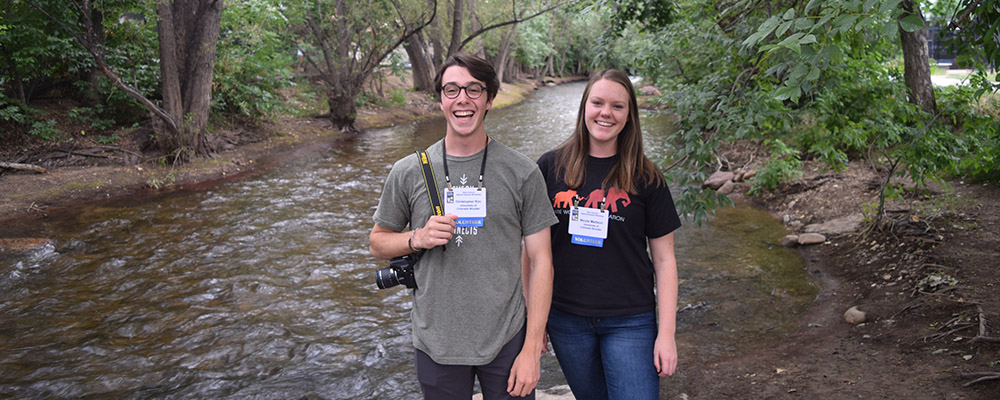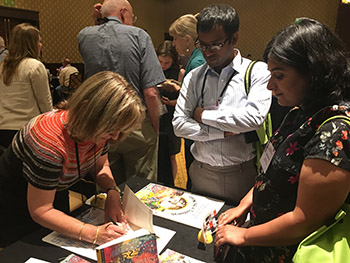 Natural Hazards Center undergrad research assistants Christopher Rini and Nicole Mattson stop along Boulder Creek during the Natural Hazards Workshop barbecue. ©Zoe Welz, 2017.
Natural Hazards Center undergrad research assistants Christopher Rini and Nicole Mattson stop along Boulder Creek during the Natural Hazards Workshop barbecue. ©Zoe Welz, 2017.
After 42 years of hosting the Natural Hazards Workshop, we wanted to get a perspective of what the event looked like from the eyes of the a new generation of hazards professionals, so we asked our undergraduate research assistant Nicole Mattson to write about her most prominent impression. Read on to get a view of the 2017 Workshop from the viewpoint of a talented (and not-at-all biased) student.
Attending a large workshop for the first time can be overwhelming for an untried undergraduate student, but such an event can be a potential turning point for students considering their studies and future career paths. Fortunately for me, the 42nd Annual Natural Hazards Workshop turned out to be exactly what I needed.
I had been feeling some uncertainty about pursuing the field of disaster and hazards research, particularly with respect to my interests in anthropology and psychology since I was still relatively new to this community and was not entirely sure how welcoming engineers and policy makers would be of this wannabe social scientist.
Going into the workshop, I feared that these two fields might not be relevant to the hazards community. I was also worried that there would be a rigid hierarchy (where I would rank at the very bottom) and that I would have nothing to offer these intelligent and experienced disaster researchers and practitioners.
However, in an intimidating sea of important professionals, sometimes all a timid undergraduate student needs to make her workshop experience is an encounter with a research idol. For me, that transpired during the Meet the Authors event where I had the great pleasure of speaking with Katherine Browne, a cultural anthropologist who spent nearly 45 minutes discussing her research, my interests, and the role of anthropology within disaster research with me.

Katherine Browne signs books for Vanika Arora and Sudipta Roy at the 2017 Meet the Authors event at the Natural Hazards Workshop. ©Nicole Mattson, 2017.
Browne echoed many of the frustrations I had begun to feel throughout the workshop about the lack of prominence and practical consideration for the role of local culture in disaster preparedness and response. She highlighted how important it is for budding anthropologists like me to be involved—reviving my conviction that what I am studying is, indeed, valuable!
I bought Browne’s book, “Standing in the Need: Culture, Comfort, and Coming Home After Katrina,” (and I tried not to geek out too much when she signed my copy) and figured that’s where it would end. So I was surprised when she not only struck up another conversation with me, the lowly undergrad student, at the Tuesday night Barbecue, but also recognized me during one of my favorite interactive sessions called Who Lives Here? Locating and Leveraging Culture to Promote Community Resilience the following day.
Of course this is just one personal experience, and Browne is an exceptionally warm and supportive individual. However, it does demonstrate the sense of inclusivity and lack of a strict pecking order at the Workshop, which makes it markedly different from other events like it.
Going into the workshop, I assumed no one really cared what I had to say, but I found the opposite to be true. People continuously asked for my opinion, seeking a new perspective and being open to hearing something that didn’t necessarily confirm what they already knew. Nothing showed this better than the overwhelmingly warm reception for Emma Sun, a 14-year-old member of the Envision Utah Youth Council who presented at the Changing Contexts, Changing Climates panel and for 16-year-old Jerome Dinakar of the FEMA Youth Preparedness Council who was a speaker at the final plenary, Taking Action in Communities Vulnerable to Disaster.
Their contributions to the respective sessions were so profound and refreshing and the audience’s response to them showed the authentic quality of the openness and eagerness to include different perspectives. It left me hopeful for the future, especially considering my preconception that my own voice was not necessarily significant. I was continually surprised, not only by the genuine curiosity and desire to share new knowledge, but also by the heart-felt attempts among the participants to create, maintain, and strengthen connections with old friends and new.
To have stumbled upon such a community has been an incredible stroke of luck, and the workshop highlighted, at least for me, a general aspiration to embrace inclusivity and find practical ways to incorporate local, context-specific knowledge to better help communities threatened by disasters. This direction for the future has given me optimism for my own studies and has only continued to demonstrate why this field is critically important.
The desire to include so many diverse voices and interdisciplinary collaboration is a real strength and has certainly allowed a first-time undergraduate student like myself to feel welcome. I am already impatiently awaiting the 43rd Annual Natural Hazards Workshop!
Nicole Mattson is an undergraduate at the University of Colorado at Boulder. As a double major in anthropology and psychology, she is interested in exploring the diverse ways in which people and institutions interact within the context of their many environments.